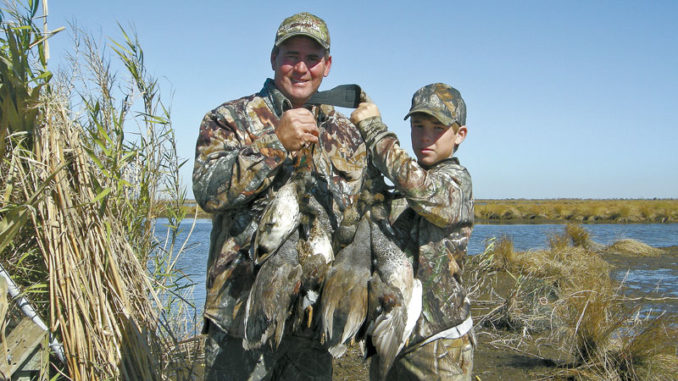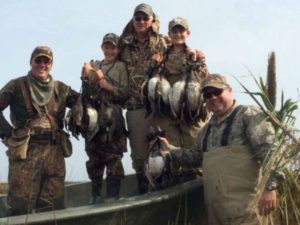
Try these tips to pick off wary birds this month
Although it seems like opening day just happened, the final weeks of duck season are already here.
All of the prep work earlier in the fall — brushing the blind, putting out a perfect decoy spread, scouting birds and practicing with your gun — will culminate in the next few weeks as another season heads into the history books.
To make the most of your remaining time in the blind, Capt. Nick Poe with Big Lake Guide Service and David Faul with Bin There Hunting shared a few key tips to knock down wary birds that have heard every bad duck call from Canada all the way to the Gulf Coast.
“You’re no longer hunting teal, you’re hunting smarter birds that have been shot at — a lot,” Poe said. “Mallards, pintail, widgeon: birds that are already pretty leery, and smarter than blue-winged teal in early November.
“They’re well-educated — they’ve seen it all by then.”
Here are their top tips to down more ducks in January.
1. Camo is king
This tactic sounds simple and it really shouldn’t change from opening day, but as blinds get beaten up during the course of a season, it’s important to remember to spruce up your brush as things wind down.
“Being hidden is the end-all, be-all,” Poe said. “If you’re not hidden, they’re not going to come.”
To that end, he makes it a point to re-brush his marsh blinds every single week of the season.
“I’m re-brushing constantly,” he said. “And I keep the old brush. I try to make the blind look as much like an island as I can. All of the old brush still gets used — even if I pull it off when I’m putting fresh brush on, I throw it on top of the boat hide.
“At the end of duck season, I’ve got like 100 pounds of grass piled up on there.”
And Faul makes it a point to keep things tidy around his blinds, which are located in rice fields.
“If you’ve got three boxes of shotgun shells around your blind in the water, all that shiny floating stuff is just something else to make them flare,” Faul said. “We’re pretty active about picking up our trash every morning.”
2. Tweak your decoy spread
“I hunt with a bunch of decoys early in the year. I think a big factor that not many people pay attention to — especially if they’re hunting in the marsh — is the number one thing you see when you see ducks sitting in the marsh, you see them somewhere in the vicinity of a big wad of coots,” Poe said. “And I’m a firm believer in coot decoys. If you don’t have your coot to duck decoy ratio correct, it’s going to be harder for you to kill ducks as the season goes on.
“Right now, I’ve got 12 dozen coots to 3 dozen ducks, and I would actually like to be hunting about 15 dozen coots with 3 dozen ducks.”
As the season progresses, Poe does pick up some of his duck decoys — but not his coots.
“I might end up having 25 dozen coot decoys out at the start of the second split, and I won’t pick that up because that’s your draw. You can see that black from a long way away. You blow that call and the duck looks in your direction and sees that black,” he said. “He’s coming to it because that’s what ducks do – they love landing with coots in the marsh.”
 Faul, who favors teal and gray duck decoys in the rice fields he hunts, downsizes his decoy spread after the second split.
Faul, who favors teal and gray duck decoys in the rice fields he hunts, downsizes his decoy spread after the second split.
“I reduce toward the end of the season,” Faul said. “I’ll also move two or three dozen out in the middle to open things up, and just leave a few nearer the blind.”
But even late in the season, Faul is still a fan of Mojo Duck mechanical decoys.
“I put them out just about every morning. If they’re working, fine,” Faul said. “It only takes two minutes to jump out of the blind and grab them and pull them in if that first flock comes through and they flare.”
3. Tone down your calling
“Less is best. I’m a firm believer, especially in the rice fields when birds are working, to just do a little light feed call or a quack-quack. That big hail call is a last resort if they’re leaving,” Faul said. “Really and truly, with rice field hunting, they’re either coming in or they aren’t.
“As long as they’re working, shut up. That’s how I’ve always thought about it.”
Poe, who admittedly enjoys calling, said he lets the ducks decide each day on how aggressive he can be with his calls.
“I start every morning the same way: I’m going to scream my head off at them,” Poe said. “If I get a reaction, then I’m going to keep doing it.
“If I get a negative reaction, I might quiet it down.”
If he can at least get the ducks’ attention and get them to break his way, that’s when Poe backs off of the call late in the season.
“Once you’ve got them and they’re coming in your direction, it’s either just shut up and don’t say a word, or sit there and make little quiet duck sounds,” he said. “I’m not talking about high-balling at them.
“I’m talking about little chuckles and that kind of thing – subtle sounds.”
One call Poe definitely uses more late in the season is his whistle, as ducks start pairing up and drakes get more vocal.
“The whistle I think is a real big deal late in the year,” he said. “But just because it’s a whistle, it doesn’t mean you blow it like a whistle. You have to actually call the ducks — you hear people all the time that see a group of pintail and it sounds like a team of football referees.
“When ducks are calling on the water and you watch them call at other ducks, they don’t do all that. You’ve got 50 pintail and there’s only one in the whole bunch that’s making any noise.”
So use some of these tips to enjoy the last few days and weeks of duck season — and maybe try Faul’s last bit of advice if nothing else seems to be working.
“Keep your fingers crossed,” he said with a laugh. “It’s 90 percent luck with weary birds late in the season. Do whatever you can do, but sometimes it’s really still a matter of luck.”


